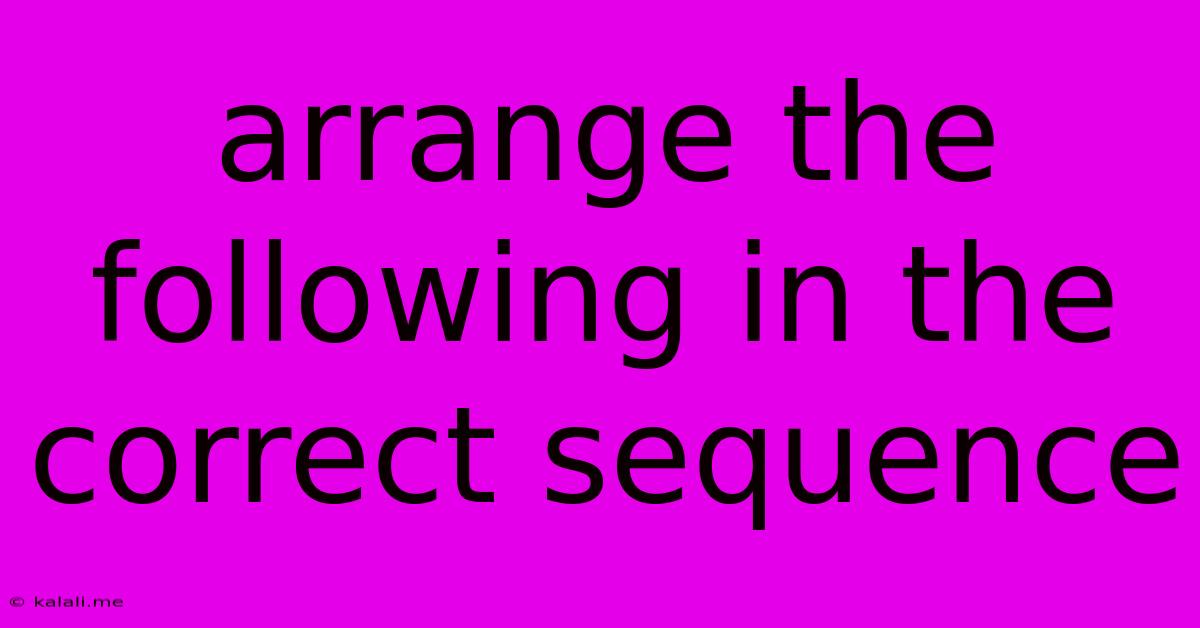Arrange The Following In The Correct Sequence
Kalali
Jun 15, 2025 · 3 min read

Table of Contents
Arranging Items in the Correct Sequence: A Comprehensive Guide
This article will delve into the strategies and techniques for correctly sequencing items, whether it's a chronological order of events, a logical progression of steps in a process, or the proper arrangement of elements in a list. Mastering sequence is crucial in various aspects of life, from writing compelling narratives to understanding complex instructions and even solving puzzles. This guide will equip you with the skills to accurately and efficiently order items, making your work clearer, more understandable, and ultimately, more successful.
Understanding Different Types of Sequences:
Before diving into the strategies, it's important to grasp the different types of sequences you might encounter. The correct order is heavily dependent on the context. Some common types include:
- Chronological Sequence: Arranging events in the order they occurred in time. This is often used in historical accounts, biographies, and narratives.
- Logical Sequence: Arranging items based on a logical relationship, such as cause and effect, steps in a process, or a hierarchical structure. This is common in instructions, explanations, and argumentative essays.
- Spatial Sequence: Arranging items based on their physical location or position. This is frequently used in descriptions of places, scenes, or objects.
- Numerical Sequence: Arranging items based on numerical value, such as ascending or descending order. This is common in mathematical problems, data analysis, and lists.
Strategies for Correct Sequencing:
Now, let's explore the practical strategies to master sequencing tasks:
1. Identifying Key Indicators:
- Time-based clues: Look for words like before, after, then, finally, initially, subsequently, etc., which provide chronological cues.
- Cause-and-effect relationships: Identify cause-and-effect relationships to determine the logical order. Look for words and phrases indicating consequence (therefore, as a result, consequently).
- Spatial descriptors: Pay attention to words indicating location or position (above, below, next to, inside, outside).
- Numerical indicators: Look for numbers, dates, or any other numerical information to establish order.
2. Creating a Visual Representation:
Visual aids can significantly improve your ability to arrange items correctly. Consider these options:
- Timeline: For chronological sequences, a timeline provides a clear visual representation of events over time.
- Flowchart: For logical sequences, a flowchart helps visualize the steps in a process and their relationships.
- Mind map: A mind map can help organize information and identify connections between items, particularly useful for complex sequences.
3. Utilizing Organizational Tools:
Several tools can assist in sequencing:
- Numbering: Assigning numbers to items allows you to easily arrange them in numerical sequence.
- Outlining: Creating an outline helps structure information and ensures a logical progression of ideas.
- Sorting software: Spreadsheet software or dedicated database programs can help sort data based on various criteria.
4. Checking for Internal Consistency:
Once you have arranged the items, review the sequence carefully to ensure internal consistency. Does the order make logical sense? Are there any contradictions or inconsistencies?
Example: Arranging Steps in a Recipe
Let's say you have the following steps in a recipe, jumbled up:
- Mix dry ingredients.
- Bake for 30 minutes.
- Add wet ingredients.
- Preheat oven to 350°F.
The correct sequence, using logical sequencing, is: 4, 1, 3, 2. The preheating must come before mixing and baking.
By applying these strategies, you'll significantly improve your ability to arrange items in the correct sequence, leading to clearer communication, more efficient problem-solving, and a better understanding of complex information. Remember to carefully consider the context and utilize appropriate tools and strategies to achieve accuracy and efficiency.
Latest Posts
Latest Posts
-
Unit Of Pressure In Cgs System
Jun 15, 2025
-
Difference Between Percent Abundance And Relative Abundance
Jun 15, 2025
-
Which Of The Following Is An Example Of An Angiosperm
Jun 15, 2025
-
Is Milk Of Magnesia A Base Or An Acid
Jun 15, 2025
-
Which Two Of The Following Statements Are True Regarding Firewalls
Jun 15, 2025
Related Post
Thank you for visiting our website which covers about Arrange The Following In The Correct Sequence . We hope the information provided has been useful to you. Feel free to contact us if you have any questions or need further assistance. See you next time and don't miss to bookmark.